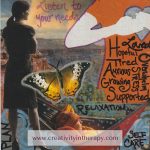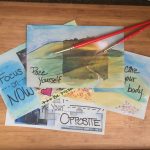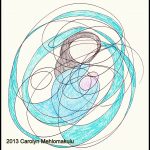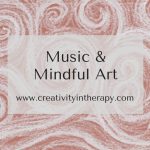This is Part 2 of my posts about the use of collage in art therapy. In Part 1, I offered an introduction to collage art therapy and some tips to get started using collage in therapy. In Part 2, I will offer some different interventions and suggestions for collage.
This is meant to give you some new ideas and places to start, but keep in mind that there is great room for flexibility and exploration. You can create a collage to explore just about anything that you can think of. Many of the ideas below are appropriate for therapists to try in session with clients or for you to try at home in your own art-making
1. Collage about your family: This can be a great directive for exploring and sharing about one’s family. Similar to an “introduction collage” (like discussed in Part 1), this type of collage is a means of sharing information about oneself. The prompt for this collage is to choose one image to represent each family member or choose images that express something about the culture and values of your family. You may consider how you arrange the images in order to represent the family relationships. In exploring the completed collage, somethings to consider might be:
Images chosen–what does each image say about the person that it represents?
Size–does one or more family member dominate the collage?
Placement–are the images close and overlapping or spread far apart?
2. Collage about emotions: Collage can be a great means of expressing ones feelings in art. In therapy, this can be used as an activity to begin the session and encourages the client to reflect on their emotional state–choose one or two images that express how you are feeling today. This can also be a great thing to do in an art journal–choose an image the shows how you are feeling and write a brief journal entry to go with it. I have found that this collage activity can lead to a much richer discussion in therapy than the usual question of “how are you feeling today?”
I have also used feelings collages to help children develop a better understanding of emotions. One child I worked with was initially only able to name the feelings happy, sad and mad, and he struggled with recognizing and articulating his own feelings. We worked together to choose collage pictures to represent the feelings happy, sad, and mad. As our piles of faces grew, he began to divide them up into more specific categories–excited, lonely, loved, scared, etc. Our finished collage covered three pieces of posterboard and represented twelve emotions. Although this child was still not ready to talk about his own feelings, he could tell me a little story about how each person in a picture felt and why–stories that revealed a lot about his own thoughts and emotions.
3. Inside/outside collage about identity: There are a few variations on this type of collage directive, but the main idea is to explore the difference between what one shows to others versus what one hides on the inside. The most simple way to do this is to use a large piece of paper (like 11×17) folded in half like a card. On the outside, collage images that represent how others perceive you and what you show to them. On the inside, collage the things that most people don’t know about you or that you keep hidden. Other interesting variations of this collage are to use the inside and outside of a box or the front and back of a mask.
4. Collages about beliefs, hopes, or dreams: Collage images can be used to explore one’s beliefs about a certain topic–e.g., “what do you believe about love” or “what does a healthy relationship look like.” This may help one to express or realize aspects of the belief that would not immediately come up through just talking. Collage can also help one to visualize or explore hopes for the future. Towards the end of therapy, I often have clients create a collage about their hopes and dreams for the future. It can be a helpful exercise for them to think about this, as well as share this with someone who is interested and supportive.
I hope that these ideas for collage art therapy directives help you to try out collage for yourself, whether in your own art-making, journaling, or with clients.
If you are having trouble collecting enough images, remember that the Internet can be a great source. Try using Google Image Search to find pictures–you’ll be surprised at how good the results can be for even the most abstract search terms. You can then print them out to be glued on to a collage, or you can combine them on the computer.
Want more art therapy ideas? Click here to sign up for the email newsletter.
Carolyn Mehlomakulu, LMFT, ATR is an art therapist in Austin, Texas who works with children, adolescents, and families. For more information about individual therapy, child counseling, family therapy, and art therapy services, please visit www.therapywithcarolyn.com.
This blog is not intended to diagnose or treat any mental health conditions. All directives, interventions, and ideas should be used by qualified individuals within the appropriate bounds of their education, training, and scope of practice. Information presented in this blog does not replace professional training in mental health, psychotherapy, counseling, art therapy, or play therapy. Although anyone can have a healing experience with art, art therapy requires the direction of a trained art therapist.
This blog includes affiliate links (see full disclosure here). If you’d like to help support the blog without any extra cost to you, please click through on Amazon links and shop as you normally would. Your support is greatly appreciated!





Thank you. I work part time as a Peer QHMA (in residential treatment home) and your suggestions are helpful. There are a couple people who are interested in collage and I would like to try some of your prompts.
Hi Elaine, glad to hear that you found this helpful. Hope that the collage work goes well with the residents.
What a great breakdown on how art therapy can be utilized for simply exploring! Aloha, Iʻm a graduate student finishing up my Marriage and Family Therapy degree this year and Iʻve found youʻre posts extremely helpful, especially while servicing my adult mental health clients at a 24/7 Mental Health Residential program. Iʻve been utilizing the art therapy collage intervention to help my clients with Schizophrenia, Schizoaffective d/o and those who also struggle with delusions and hallucinations. This collage intervention has worked so incredibly well around delusions and hallucinations to bring about the underlying emotions and suppressed feelings my clients cannot verbalize. Very helpful suggestions! Mahalo for sharing -Becca Hiraishi
Always so helpful! Thank you 🙂